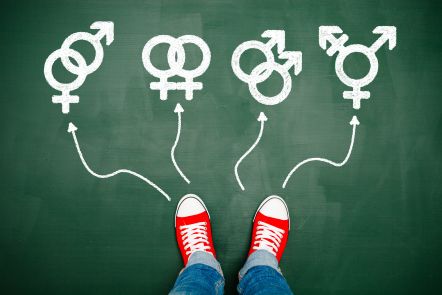Sex and gender
Different terms are regularly used in theories of sexuality and gender, for example sex, gender, gender identity, gender expressions, gender roles, sexual orientation. It is important to be clear about the meanings of such terms.

Gender is an area that cuts across thinking about society, law, politics and culture, and it is frequently discussed in relation to other aspects of identity and social position, such as class, ethnicity, age and physical ability. Gender is also an important concept within a range of social and political debates and may influence these debates differently according to cultural context.
Gender is a ‘heavy’ word: politicians and public figures often use it with negative connotations, for example in referring to ‘gender police’, or to ideologies that ‘threaten our kids’. These are examples of how gender can be misunderstood and politicised.
There are some languages which do not have a word for ‘gender’. In such cases, the word ‘sex’ is normally used, and in order to distinguish between sex and gender, different terms may be employed, for example ‘biological sex’ may be used to refer to ‘sex’, and ‘cultural and social sex’ may be used to refer to ‘gender’.
However, even when the terms exist in the language, ‘sex’ and ‘gender’ are often used interchangeably.
Definitions of sex and gender
A number of definitions have been put forward by different organisations. They provide a useful starting point for discussion.
The World Health Organisation summarises the difference between sex and gender in the following way:
Sex refers to “the different biological and physiological characteristics of males and females, such as reproductive organs, chromosomes, hormones, etc.”
Gender refers to "the socially constructed characteristics of women and men – such as norms, roles and relationships of and between groups of women and men. It varies from society to society and can be changed. The concept of gender includes five important elements: relational, hierarchical, historical, contextual and institutional. While most people are born either male or female, they are taught appropriate norms and behaviours – including how they should interact with others of the same or opposite sex within households, communities and work places. When individuals or groups do not “fit” established gender norms they often face stigma, discriminatory practices or social exclusion – all of which adversely affect health17.”

The European Institute for Gender Equality, an autonomous body of the European Union, provides very extensive definitions of sex and gender:
“Sex refers to the biological and physiological characteristics that define humans as female or male. These sets of biological characteristics are not mutually exclusive, as there are individuals who possess both, but these characteristics tend to differentiate humans as females or males.”
“Gender refers to the social attributes and opportunities associated with being female and male and to the relationships between women and men and girls and boys, as well as to the relations between women and those between men. These attributes, opportunities and relationships are socially constructed and are learned through socialisation processes. They are context- and time-specific, and changeable. Gender determines what is expected, allowed and valued in a woman or a man in a given context. In most societies, there are differences and inequalities between women and men in responsibilities assigned, activities undertaken, access to and control over resources, as well as decision-making opportunities. Gender is part of the broader sociocultural context. Other important criteria for sociocultural analysis include class, race, poverty level, ethnic group and age.”19
Other definitions 20 and general differences between the terms

- Sex refers to biological differences between males and females (e.g. gonads, sexual organs, chromosomes, hormones).
- Sex is usually assigned at birth (there are examples when it is assigned later, when sex characteristics do not clearly indicate the sex of the baby, for example in the case of ‘intersex’ people).
- Sex can be changed: in the case of transsexual people, who are born with the sex characteristics of one sex and gender identity of the other, sex reassignment surgeries are performed. This includes a change of sex organs and the administration of hormones.
Gender
- Gender is a social, psychological and cultural construct and it is developed in the process of socialisation. Different societies and cultures may therefore have different understandings of what is ‘masculine’ or ‘feminine’. Societies create norms and expectations related to gender, and these are learned in the course of people’s lives – including in the family, at school, through the media. All of these influences impose certain roles and patterns of behaviour on everyone within society. Gender norms – often limited to notions of masculinity and femininity – change over time, but are usually based on a heteronormative order which stipulates that there are two sexes (genders) and they are attracted to each other. People who do not appear to fall under this binary notion of gender often suffer from exclusion, discrimination and violence.
- Gender is both an analytical category – a way of thinking about how identities are constructed – and a political idea which addresses the distribution of power in society.

- Gender norms vary across different cultures and over time.
- Traditional gender norms are hierarchical: they presuppose an unequal power structure related to gender that disadvantages mostly women.
- Gender is not necessarily defined by biological sex: a person’s gender may or may not correspond to their biological sex. Gender is more about identity and how we feel about ourselves. People may self-identify as male, female, transgender, other or none (indeterminate/unspecified). People that do not identify as male or female are often grouped under the umbrella terms ‘non-binary’ or ‘genderqueer’, but the range of gender identifications is in reality unlimited.
- Gender is deeply personal to every individual: some people recognise their gender identity early in childhood, and some only later on.
- Gender intersects with other categories, such as class, skin colour, ethnicity, religion or disability. Read more about intersectionality.
- Gender is something we express (gender expression), sometimes intentionally, and sometimes without thinking. We communicate our gender in a number of ways, for example by the way we dress, the way we move, our hair style, and the way we interact with others21.

Gender may appear to be a complicated idea, but once the biological determinism common in everyday thinking about differences between women and men is challenged, it becomes easier to understand gender.
Aspects of sex will not vary substantially between different human societies and over time, while aspects of gender may vary greatly.
Examples of sex characteristics
- Women can menstruate while men cannot.
- Men have testicles while women do not.
- Women have developed breasts that are usually capable of lactating (producing milk) while men have not.
- Men generally have bigger bones than women.
Examples of gender characteristics
- In most countries, women earn significantly less than men.
- In some countries, the tobacco industry targets women by “feminising” cigarettes packaging for certain brands (small “purse” packs that resemble cosmetics and evoke slimness, the use of “feminine” colours, such as pink).
- In most countries of the world, women do more housework than men.
- In some countries, the law allows people to marry a partner of the same sex; in other countries this is not allowed.
17 Source: World Health Organization - Gender, equity and human rights: Glossary of terms and tools.
18 The Council of Europe Convention on preventing and combating violence against women and domestic violence.
19 Source: European Institute for Gender Equality (EIGE) - Glossary & Thesaurus.
20 You can find more definitions in the Gender Equality Glossary, Council of Europe 2016.
21 Source: Diagram of Sex and Gender. Center for Gender Sanity.


